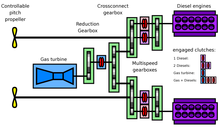- Combined diesel and gas
-
Combined
marine
propulsionCombined diesel and gas (CODAG) is a type of propulsion system for ships which need a maximum speed that is considerably faster than their cruise speed, particularly warships like modern frigates or corvettes.
It consists of diesel engines for cruising and gas turbines that can be switched on for high-speed transits. In most cases the difference of power output from diesel engines alone to diesel and turbine power combined is too large for controllable pitch propellers to limit the rotations so that the diesels can continue to operate without changing the gear ratios of their transmissions. Because of that, special multi-speed gearboxes are needed. This contrasts to CODOG systems, which couple the diesels with a simple, fixed ratio gearbox to the shaft, but disengages when the turbine is switched on.
E.g. for the new CODAG propulsed Fridtjof Nansen class frigate of the Royal Norwegian Navy, the gear ratio for the diesel engine is changed from about 1:7.7 (engine:propeller) for diesel-only to 1:5.3 when in diesel-and-turbine mode. Some ships even have three different gear ratios for the diesel engines: one each for single diesel and double diesel cruises and the third when the gas turbine is engaged.
Such a propulsion system has a smaller footprint than a diesel-only power plant with the same maximal power output, since smaller engines can be used and the gas turbine and gearbox don't need that much additional space. Still it retains the high fuel efficiency of diesel engines when cruising, allowing greater range and lower fuel costs than with gas turbines alone. On the other hand, a more complex, heavy and troublesome gearing is needed.
Typical cruising speed of CODAG warships on diesel-power is 20 kts and typical maximal speed with switched on turbine is 30 kts.
CODAG has been pioneered by Germany with the Köln class frigate.
Contents
Turbines and diesels on separate shafts
Sometimes the engine arrangement of diesel engine and gas turbine with each system using its own shafts and propellers is also called CODAG. Such installations avoid the use of a complicated switching gearbox but have some disadvantages compared to real CODAG systems:
- Since more propellers have to be used, they have to be smaller and thus less efficient.
- The propellers of the idling systems cause drag.
CODAG WARP
CODAG Water jet And Refined Propeller, a system developed by Blohm + Voss as option for their MEKO line of ships, also falls in this category but avoids the above mentioned problems. CODAG WARP uses two diesel engines to drive two propellers in a CODAD arrangement, i.e. both shafts can also be powered by any single engine, and a centerline water jet powered by a gas turbine. The idling water jet doesn't cause drag and since its nozzle can be placed further aft and higher it doesn't affect the size of the propellers.
CODAG-electric
Another way to combine the two types of engines is to connect them to generators and drive the propellers electrically as in a diesel-electric (See
- REDIRECT CODLAG, Combined Diesel-Electric and Gas). The RMS Queen Mary 2 uses this design. This also permits propeller pods with the propulsion motors inside the pods. A further CODAG innovation on the QM2 is to mount the turbines not in the engine room but directly under the funnel, simplifying the fresh air supply.
CODAS (Combined diesel-electric and steam)
This is a Diesel engine with a boiler to extract heat from the cylinder and the exhaust gases, generating steam at a rate proportional to the fuel flow. The steam is separately injected into the cylinder close to top dead center, actively modifying combustion and afterburning. The steam to fuel mass ratio is preferably 1:1 to 3:1 and the steam temperature and pressure are as high as engine materials permit. This system, adaptable to large Diesel engines, strongly reduces fuel consumption and emissions.
See also
- Combined gas and gas (COGAG)
External links
- CODAG WARP @ naval-technology.com
Categories:
Wikimedia Foundation. 2010.

